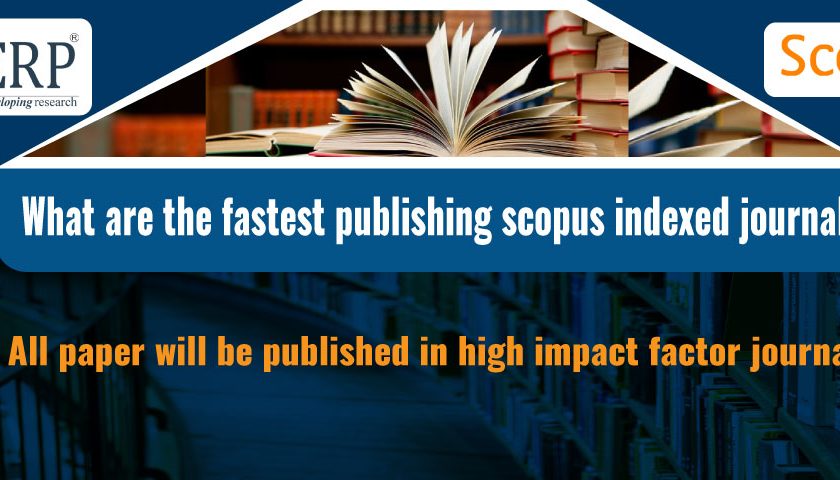Research and experimentation are more often than not tedious, long-drawn processes that necessitate careful design, optimization, and replication of experiments. By the time you have accumulated enough data to write a manuscript, you will most likely wish to publish it as soon as it is practicably feasible. Accelerated publication can quicken the propagation of research outcomes, diminish the possibility of being recovered, and also provide for a more expeditious return to carrying out more research work on an entirely new phenomenon or topic. Irrespective of whether one is currently experimenting or writing, the following tips can help them increase their manuscript publishing speed with a high-impact Scopus journal of their choice.
- Data Is Key
- Designing integral experiments with research publication in mind, including the proper controls and layout, helps cut down significantly on time wasted recapitulating work to get wholesome or satisfactory data.
- Also, researchers should remember to capture and note down their data early, in particular, because this process can get lengthier and more intimidating if weeks or months have passed since the researcher has accumulated the data.
- IFERP’s academic services are an excellent source of professional support and assistance with formatting figures or producing charts to better elucidate and depict research data, especially when the researcher is pressed for time.
- Taking part in an upcoming educational conference 2023 being organized by IFERP will help enlighten those who know very little or don’t quite understand the importance of getting data accumulation and presentation right.
- Fully Comprehending The Significance Of The Research Paper Is Integral
- Understanding the subject assigned to the researcher is necessary in order to write a great research paper.
- Why is this important? Because only when a researcher fully understands the scope of the research will they be able to carry out the sort of high-quality that will make it possible for them to get their manuscript published as quickly as possible in a renowned Scopus-indexed journal.
- Most researchers neglect the instructions given by their instructors. It is absolutely crucial to consider every little detail of instruction and diligently study the manuscript, scoring criteria, or other relevant material that has been provided.
- Making Sure To Carefully Choose A Topic Of Research
- If one is free to choose any research topic to write their research paper, they should take the opportunity and go for the one that interests them only.
- This will provide them with adequate motivation to participate in relevant research for it.
- Therefore, being determined when choosing a topic, bearing fast and undeterred publication in mind while doing so will help immensely.

- Before one can even proceed to find fast publish Scopus journals 2023 for their research paper, they should think carefully about what topic they want their research to be focussed on.
- By picking a research topic that is unique (and then by following all the tips detailed below), they are sure to have their manuscripts approved and published in quick time.
- Getting Started With The Writing Process From The Get-Go
- Even if one doesn’t have a full set of experiences, they can start writing their article right away.
- The context/introduction section, which is usually based on previous research, lends itself particularly well to pre-writing.
- Writing the materials and methods section while the protocols are still fresh in one’s mind can also speed up manuscript preparation, which in turn leaves time for finding a Scopus indexed journal 2022 that guarantees fast manuscript processing and publication.
- Ensuring Crisp & Uncluttered Manuscript Writing
- The quick publication of well-thought-out research work with implications of considerable significance can be hindered because of the lack of straightforward and to-the-point writing on the part of the research author.
- This is because both editors and peer reviewers may find it tough to comprehend the content and may also develop negative biases towards poorly written manuscripts, making the possibility of rejection even more likely.
- This is a specific barrier to quick publication for those who come under the category of non-native English speakers.
- Taking time to attend an upcoming conference in 2023 in one’s field will surely stand them in good stead when it comes to learning about unique ways to ensure writing a manuscript as straightforward and professionally as possible.
- Making Full Use Of Reference Formatting Tools
- These tools can be utilized to archive relevant references, reducing the time spent searching for articles one has already read previously.
- Additionally, when working on a manuscript, citation managers can automatically format a researcher’s citations as per their target journal’s guidelines and update their citation list whenever they add or remove a citation, saving them time.

- This makes it easier for editors and peer reviewers to be able to verify the citations easily, thereby approving a manuscript quicker and publishing it without any delays.
- Carrying Out Vital Research
- One’s university library will be a first-rate and credible source of information if they are tasked with writing a manuscript for their research article.
- They will find countless books, journals, and articles based on their given topic in the library.
- Therefore, opting for a secluded location to accomplish research is important. What’s more, one can even try using a PC and a catalog to write an academic article hassle-free.
- The most crucial things to remember when carrying out research is to browse through content, delve into genuine sources, and never overlook useful information.
- This is one of the keys to writing a great manuscript and getting it published in a high-profile Scopus indexed journal quickly.
- Ensuring That The Manuscript Is Well-Structured
- One of the most exclusive ways to write a research paper is to organize it all.
- One may have all the relevant information, but not knowing how to organize the information may result in a below-par manuscript, thereby causing publication to be delayed.
- If the target journal’s requirements require preparing a bibliography of it along with one’s academic work, they should be sure to prepare it while meeting all the requirements.
- One needs to think about how they want to summarize the whole manuscript. It’s great for bookmarking those resources, or they can also prepare a digital bibliography that lets them link to the sources they’ve found.
- Adhering to the format prescribed by the target journal will help in breezing past the peer-review process and get published quickly.
- Carrying Out Regular Previews
- One can start preparing a preview after they have carried out extensive research.
- With all the manuscripts and essential data they have accumulated, it is best that they let the brainstorming adjust to the defined topics.
- Making a rough draft where the part should be at the beginning, in the middle, or at the end helps.
- This is an essential step in shaping one’s research and, as a result, their manuscript, eventually helping in quick publication.
- Getting It Right From The Very First Draft
- Once one has carefully defined the manuscript, one can begin to write their first draft.
- With this outline, they can write down all the ideas and form relevant paragraphs with them.
- This is one of the main parts where they need to incorporate more detail so that the research instructors can take a look and offer their advice on what changes to make in order to make the job of the reviewers at their target journal easier, thereby increasing the chances of quick approval and publication of the manuscript.
- Proofreading The Content Comprehensively
- After completing the manuscript, one should start editing and proofreading all of their content after proofreading their first draft.
- They should make relevant changes if they think certain changes need to be made.
- They should then summarize their final draft.
- Once they are done, they should verify that all the necessary information is added and also edit and reread the written sentences to keep their flow natural and smooth.
- It is also essential to do a thorough check for grammatical and typographical errors.
- In the meantime, they should not forget to check spelling and all reliable sources, which should be on the bibliography page, as this would be an important part of editing and proofreading.
- Carrying out a critical evaluation of one’s own manuscript will help them spot and rectify all the mistakes that a researcher would be likely to spot and, as a result, not only decrease the chances of them getting rejected but also quicken the publication of their manuscripts.
- Knowing When To Submit A Manuscript
- If one already has a large amount of data but is still continuing to carry out their experiments, they consider whether their research can be split into two separate papers or articles.
- This approach will allow earlier studies to be published more quickly, even before subsequent studies are completed.
- Seeking Peer Review Before Publication
- With the help of a professional critiquing service (like the one offered by IFERP) which provides peer review before a manuscript is submitted to a journal, one can further increase the speed of publication of their manuscript.
- One can also just get feedback from their colleagues on the strength of their paper using the service provider’s team of experienced professionals.
- With these reviews in hand before submitting, one can avoid some of the objections of journal reviews.
- Picking The Right Journal
- To increase the likelihood of acceptance of an article, one should try selecting a journal whose scope matches their research objective.
- Talking with their colleagues, reviewing their own list of journals and publications, and browsing journal websites and recent tables of contents can help.
- One can also consider Scopus journals and editors that promote a faster time frame between submission and decision making.
- Submission to open access journals that are known to focus on scientific validity rather than novelty and importance can help speed up publication as well.
- Staying In Touch With The Journal Authorities
- A pre-submission request consists of a letter written to a journal to assess their interest in their manuscript.
- This survey can help quickly determine if their article would be suitable for the journal without having to go through the entire submission and peer review process.
- Different journals may have different requirements for the content of these applications; for example, some journals require submission of a manuscript abstract with a cover letter.
- In some cases, a pre-submission survey may actually be required.
- Adhering To The Target Journal’s Prescribed Guidelines
- Carefully following the target journal’s guidelines for –
- primary text,
- references,
- cover letter,
- figures and tables, and
- any extra details to circumvent unnecessary delays in publication go a long way.
- IFERP’s manuscript editing service can help facilitate compliance with these guidelines effortlessly.
- Carefully following the target journal’s guidelines for –
- Having A Top-Notch Cover Letter
- The cover letter that accompanies one’s submission offers an opportunity to highlight the relevance of their work to the journal and present their primary findings.
- A great cover letter sent to the right Scopus indexed journal can potentially convince the editor to immediately send one’s manuscript for review and have it published immediately.
- Registering and taking part in this 2023 international conference will help immensely in learning about crucial cover letter preparation and writing tips that will stand every researcher in good stead when it comes to getting their manuscript accepted, approved, and published quickly.
- Following Up With The Journal Periodically
- If one has submitted their manuscript to a journal but still has not received a decision, they may consider checking with the editor on the status of their submission.
- The general time between submission and decision-making can change depending on the journals and disciplines, so one may want to confer with their colleagues or check the journal’s website to determine if they’ve waited longer than usual.
- Following up with the journal is crucial to getting published quickly.
- Writing An Effective Response To Reviewers
- A comprehensive, clear, and polite response to comments from editors and reviewers will help reduce the likelihood of rejection or another review cycle, saving one a considerable amount of time.
In 2016, one of the world’s most popular journals revealed that the review period for manuscripts submitted to it over a 10-year period had been reduced from 85 days to 150 days. In PLoS One, it went from 37 days to 125 days during the same period. The length of the review can mean that a researcher’s article can be edited for almost a year, especially if that author is looking for high-impact journals. Publishing an article before printing can mean that an author does not have to keep waiting for even more time until their research is published once the article is accepted.
On examining the benefits of faster posting, one will find a lot of interesting things. Right now, the way a scientific career works is that a researcher has to amass as many publications as they can. The better the journals they publish in, the more grants they receive, etc. This is the way in which the world of academia and research works. Researchers working with a “publish or perish” mentality must publish often and quickly in order to earn additional research dollars for their institutions. Often, personal advancement in a researcher’s institution relies on frequent publications.
This means that their ability to achieve permanence is tied to the number of articles they have published, so it is in the interest of publishers to increase the speed of publication. Being known as a journal that quickly publishes original research means that a journal could potentially begin to be seen as the best resource for innovation. This reputation can then lead to an increase in submissions, as authors will begin to be drawn to a journal that publishes content fast. And, of course, readers gain from faster publication as they gain access to the most recent, groundbreaking research developments that could potentially change the direction of other scientific pursuits. Wherever one is in the research and writing process, these tips will prove to be crucial in helping them not only speed up the publication of their manuscript but also easily publish their research paper.


